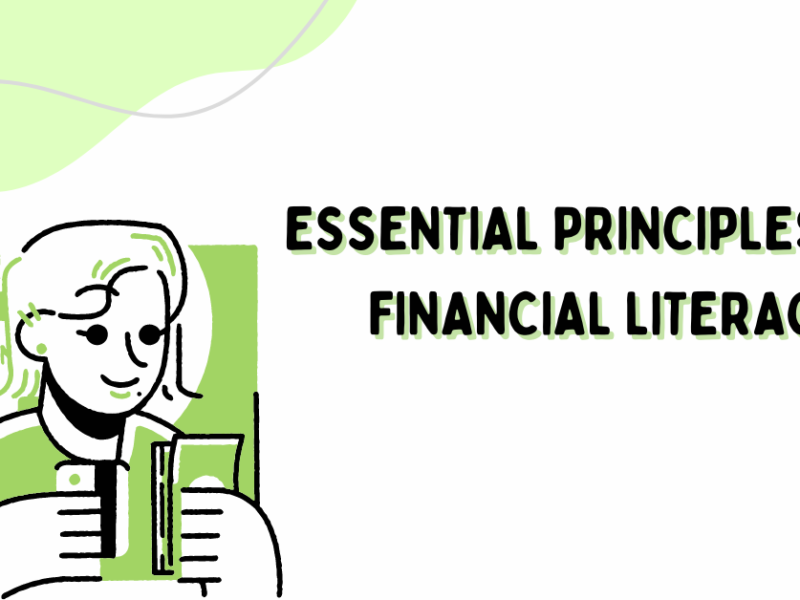In today’s complex and ever-changing financial landscape, achieving financial stability and success requires more than just earning a paycheck and paying bills. It demands a deep understanding of key financial concepts, prudent decision-making skills, and a commitment to ongoing learning and improvement. In this comprehensive guide, we will explore the importance of financial literacy and provide practical strategies for strengthening your financial literacy muscles to achieve financial fitness.

Understanding Financial Literacy
Financial literacy is the cornerstone of financial well-being, empowering individuals to navigate the complex world of personal finance with confidence and competence. Financial literacy encompasses a broad spectrum of knowledge and skills essential for making informed and effective financial decisions.
Budgeting, the foundation of financial literacy, involves creating a plan for managing income and expenses to achieve financial goals. By budgeting effectively, individuals can prioritize spending, allocate resources wisely, and avoid overspending, laying the groundwork for financial stability and success.
Saving is another fundamental aspect of financial literacy. It involves setting aside money for future needs and goals. Whether saving for emergencies, major purchases, or retirement, the ability to save systematically is crucial for building financial resilience and achieving long-term financial security.
Investing, the art of putting money to work to generate returns, is a key component of financial literacy. Understanding different investment options, such as stocks, bonds, mutual funds, and real estate, and knowing how to assess risk and potential returns are essential for growing wealth and achieving financial goals over time.
Debt management is an important aspect of financial literacy, encompassing strategies for borrowing responsibly, managing debt effectively, and avoiding excessive debt. By understanding different types of debt, such as credit card debt, student loans, and mortgages, individuals can make informed decisions about borrowing and repayment, minimizing financial stress and maximizing financial health.
Retirement planning, a critical element of financial literacy, involves:
- Preparing for life after work by setting goals.
- Estimating retirement expenses.
- Saving and investing for retirement.
Understanding retirement accounts, such as 401(k)s, IRAs, and pensions, and knowing how to maximize retirement savings and benefits are essential for achieving financial security in retirement.
In addition to these core areas, financial literacy encompasses various topics, including tax planning, insurance, estate planning, and financial decision-making. By acquiring knowledge and skills in these areas, individuals can make informed choices about their finances, minimize financial risks, and confidently achieve their financial goals.
Ultimately, a strong foundation in financial literacy empowers individuals to take control of their financial lives, make informed decisions, and achieve financial well-being. By investing in financial education and lifelong learning, individuals can build a brighter financial future for themselves and their families, one informed decision at a time.
The Importance of Financial Fitness
Financial fitness is not just about having a healthy bank balance; it’s about having the knowledge, skills, and habits to effectively manage your finances, achieve your financial goals, and overcome financial obstacles. Much like physical fitness, achieving financial fitness requires regular practice, discipline, and a commitment to ongoing improvement.
Financial fitness is about ablenancial decisions, adapting to changing circumstances, and building a secure financial future for yourself and your family. It involves developing prudent financial habits, such as budgeting, saving, investing, and debt management, that enable you to maximize your financial resources and achieve your long-term financial goals.
Just as regular exercise is essential for maintaining physical health, ongoing education and learning are critical for achieving and maintaining financial fitness. This includes staying informed about personal finance topics, such as budgeting, investing, retirement planning, and tax strategies, and continuously seeking opportunities to improve your financial knowledge and skills.
Prudent financial habits are also key components of financial fitness. This includes living within your means, avoiding unnecessary debt, and prioritizing saving and investing for the future. By developing and maintaining these habits, you can build a solid financial foundation and reduce the likelihood of financial stress and uncertainty.
Proactive financial planning is another essential aspect of financial fitness. This involves setting clear financial goals, developing a plan to achieve them, and regularly reviewing and adjusting your plan. Whether your goals include buying a home, paying for your children’s education, or retiring comfortably, having a well-thought-out financial plan can help you stay on track and make informed decisions.
Ultimately, achieving financial fitness requires a combination of knowledge, discipline, and proactive planning. Investing in your financial education, developing prudent financial habits, and setting clear financial goals can enhance your financial fitness and build a secure financial future for yourself and your family.
Key Components of Financial Literacy:
- Budgeting and Money Management: Budgeting is the cornerstone of financial literacy. It helps individuals track their income and expenses, prioritize spending, and achieve financial goals. Effective money management involves living within one’s means, avoiding unnecessary debt, and building a solid financial foundation.
- Saving and Investing: Saving and investing are essential components of financial literacy, allowing individuals to grow their wealth over time. Saving involves setting aside money for short-term goals and emergencies. In contrast, investing involves putting money into assets such as stocks, bonds, real estate, and retirement accounts to generate long-term returns.
- Debt Management: Managing debt is a critical aspect of financial literacy, as excessive debt can hinder financial progress and lead to financial hardship. Understanding different types of debt, developing a repayment plan, and avoiding high-interest debt are essential for achieving financial stability.
- Retirement Planning: Planning for retirement is a key aspect of financial literacy, ensuring that individuals can maintain their standard of living and achieve their retirement goals. This includes estimating retirement expenses, maximizing retirement savings, and considering factors such as Social Security, pensions, and healthcare costs.
- Financial Risk Management: Understanding and managing financial risks is another important financial literacy component. This includes protecting against unexpected events such as job loss, illness, or natural disasters through insurance and diversifying investments to minimize investment risk.
Strategies for Strengthening Your Financial Literacy Muscles:
- Educate Yourself: Use resources such as books, websites, courses, and seminars to expand your knowledge of personal finance topics. Stay informed about current financial trends and developments to make informed decisions.
- Set Financial Goals: Establish clear, achievable financial goals to provide direction and motivation for your financial journey. Whether it’s saving for a home, paying off debt, or building a retirement nest egg, setting goals helps you stay focused and track your progress.
- Create a Budget: Develop a realistic budget that outlines your income, expenses, and savings goals. Track your spending, identify areas where you can cut back, and allocate funds toward your financial priorities.
- Build an Emergency Fund: Start building an emergency fund to cover unexpected expenses such as medical bills, car repairs, or job loss. Aim to save at least three to six months’ living expenses in a readily accessible account.
- Invest Wisely: Learn about different investment options and strategies, and consider seeking guidance from a financial advisor. Diversify your investments to spread risk and maximize potential returns over the long term.
- Pay Off Debt: Develop a plan to pay off high-interest debt systematically, starting with the debt with the highest interest rate. Consider debt consolidation or negotiation strategies to lower interest rates and accelerate repayment.
- Plan for Retirement: Start saving for retirement as early as possible and take advantage of employer-sponsored retirement plans such as 401(k)s or IRAs. Consider consulting a financial advisor to develop a comprehensive retirement plan tailored to your goals and risk tolerance.
- Review Your Insurance Coverage: Review your insurance policies regularly to ensure adequate coverage for your needs, including health insurance, life insurance, disability insurance, and property insurance.
- Stay Disciplined: Cultivate disciplined financial habits such as living within your means, avoiding impulse purchases, and sticking to your budget. Consistency and perseverance are key to achieving long-term financial success.
- Continuously Learn and Adapt: Stay open to learning new financial concepts and strategies, and be willing to adapt your financial plan as your circumstances and goals change over time.
Conclusion
Strengthening your financial literacy muscles is an ongoing journey that requires dedication, discipline, and continuous learning. By mastering key financial concepts, developing prudent financial habits, and taking proactive steps to achieve your financial goals, you can enhance your financial fitness and build a secure financial future for yourself and your family.
Remember, the journey to financial fitness begins with a commitment to lifelong learning and a willingness to take control of your financial destiny.



Great, thanks.